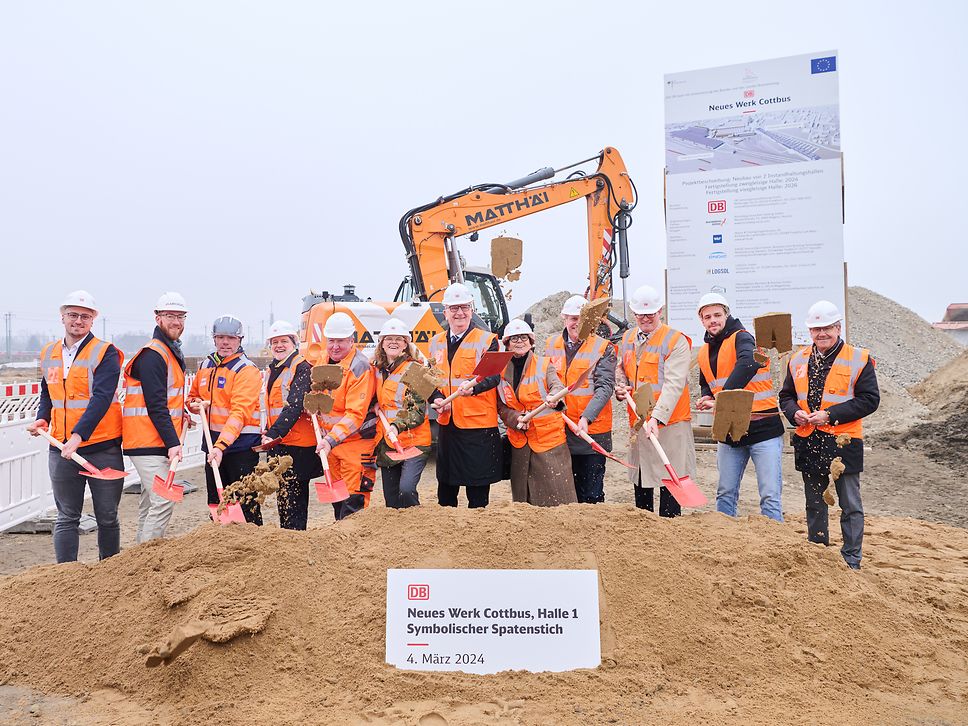Article: Next step for the largest and most modern ICE maintenance depot: ground-breaking ceremony for second hall in Cottbus
The first construction measures for the second hall of the ICE maintenance depot in Cottbus have started. Brandenburg's Minister-President Dr Dietmar Woidke and Dr Daniela Gerd tom Markotten, Member of the Management Board for Digitalization and Technology Board Division at DB, jointly turned the symbolic first sod today following the fourth meeting of the Cottbus rail site task force.
The over 500 metre long, four-track hall completes DB's largest and most modern maintenance depot. The first two-track workshop in Cottbus went into operation on schedule in January, less than 20 months after the ground-breaking ceremony. The earthworks for the second construction project also began in January, and the four-track maintenance hall plus paint shop in Cottbus is scheduled to go into operation in 2026. DB's most modern plant will then have full capacity for heavy maintenance of the entire ICE 4 fleet just four years after the start of construction.
The ICE 4 is the backbone of DB's long-distance transport network. The DB Group has ordered 137 of these trains, with a total of around 450 ICE trains of various types expected to be on the rails by the end of the decade. More trains also require more maintenance capacity. The new plant in Cottbus Maintenance Depot uses innovative technology to ensure that the trains get back on track quickly. This means that more people can travel in a climate-friendly and comfortable way - a win for the decarbonisation of transport in Germany.
Dr Daniela Gerd tom Markotten, DB Member of the Management Board for Digitalization and Technology Board Division: "After giving the go-ahead for the heavy maintenance of our ICE 4 fleet in Cottbus in January, we are now getting started with the construction of the second workshop. We are once again relying on close cooperation with construction companies and authorities in the 'rail partnership model', dialogue in the task force and local tradesmen. With this successful model, we are building not only the most modern, but also the largest ICE maintenance depot at DB by 2026. In doing so, we are making an important contribution to Lusatia, the people in the region and to strong rail in Germany."
Dr Dietmar Woidke, Minister President of the State of Brandenburg: "The new ICE plant is currently the most important project in Lusatia's structural change. It is being built at Brandenburg speed. I would like to thank everyone involved for this top performer. The wheels are meshing perfectly here. The most modern railway plant in Europe is setting new standards. Its enormous significance also lies in the fact that 1,200 new industrial jobs and apprenticeships are being created here, thus compensating for the loss of lignite jobs. Deutsche Bahn secures these jobs with an attractive collective labour agreement. Added to this is Deutsche Bahn's strong commitment to training. At the same time, we are ensuring a liveable Lusatia by expanding infrastructure such as the Lübbenau-Cottbus railway line."
Significantly faster maintenance possible
The new hall will be over 500 metres long and around 200 metres wide. From 2026, full-length ICE trains will be able to enter for maintenance on four tracks. Thanks to innovative technologies such as augmented reality glasses, apps for materials management and electrically powered material trains, the trains in Cottbus can be maintained much faster than in other plants, where they would have to be split and shunted for maintenance. This means that the trains are quickly and reliably available again for passengers travelling to Germany, Austria or Switzerland.
Training activities ramped up
The skilled labour situation in Lusatia was also on the agenda at the meeting of the Cottbus railway site task force: DB has initially hired around 450 apprentices and employees at the Cottbus site. Around 1,200 additional industrial jobs and apprenticeships are to be created by the time the hall currently under construction goes into operation in 2026. DB will fill a good half of the newly created jobs with its own apprentices; it has massively ramped up its training activities since deciding in favour of the Cottbus site.
To this end, LEAG is currently supporting DB and training young people at the training centre in Jänschwalde. From 2025, this training centre will be completely taken over by DB. Young people from DB, LEAG and other companies will be trained there for the future. DB will enable LEAG employees and others affected by structural change to make a structured transition to the railway and thus gain new prospects in Lusatia.

In the picture from left to right:
Florian Wunderlich, Senior Logistics and Factory Planner, LogsolSebastian Bartsch, Project Engineer, ArcadisThorsten Praulinsch, Senior polisher, Wayss & FreytagHermann Granig, Polisher, RhombergDr Hartmut Freystein, Head of the Berlin branch office of the German Federal Railway AuthorityDr Daniela Gerd tom Markotten, Member of the Management Board for Digitalization and Technology Board Division at Deutsche BahnDr Dietmar Woidke, Minister President of the State of BrandenburgMarietta Tzschoppe, Mayoress of the City of CottbusTobias Schick, Lord Mayor of the City of Cottbus Mathias Jessen, Division Manager Building Technologies, ENGIEDomenic Blancke, Planner, Baumert & Peschos
